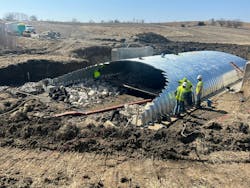One-Lane Bridge in Iowa Becomes Thoroughfare for Farming Community
Key Takeaways
- The new buried bridge in Riverside, Iowa replaces a one-lane, weight-restricted structure, saving farmers up to 30 minutes of travel time.
- The open-bottom steel buried bridge design preserves the natural streambed, allowing for uninterrupted water flow and wildlife movement.
- The cost-efficient buried bridge structure improves durability, supports heavier farm equipment, and enhances traffic flow for the local community.
By Steve Cooper, Contributing Author
A new buried bridge in Riverside, Iowa provides a shortcut to the Washington County farming community shaving off 30 minutes of unnecessary travel time.
The original one-lane bridge on Tupelo Avenue was built in 1966 with prestressed concrete beams, double-T beams and a posted weight limit of 15 tons. The county decided to replace it with a two-lane bridge structure with no weight restriction, expanding its use to the local farming community.
“We had an old, narrow bridge with a weight restriction on it of 15 tons,” said Washington County Engineer Jacob Thorius. “This was limiting the traffic’s ability to get through the area, particularly the farming community, not so much daily car traffic, but any farming operation to get through the area was restricted and had to drive around.
“People had to drive three or four miles out of their way, which had an impact in the community. That, along with it being just 20 feet wide with the barrier rail meant it was really a one-lane bridge. We needed to improve the flow of traffic and decided to replace that structure and started exploring our options. For this type of structure or bridge, we would've probably put back a twin or triple box culvert. And those work great for us.”
Thorius and his team found another solution.
“We attended NACE, the National Association of County Engineers Annual Conference,” he said. “They brought in speakers about bridges and the Short Span Steel Bridge Alliance talking about various options. Short span steel structures in Iowa aren't real common, and we have a very strong concrete bridge industry. But I wanted to explore other options to see what was there to help control cost … with minimal impact to the traveling public.
“So, my assistant looked through a variety of options — a traditional bridge, a box culvert, and then various alternative structures, whether they be a short span traditional steel bridge or a buried bridge. Ultimately, we decided to go the buried bridge route. We had never done one of these structures before. In this case, the open bottom meant that we didn't have to worry about mitigating any impacts to the streambed itself, which was really the main reason we ended up with the final structure design.”
The former bridge was 45 feet long and 20 feet wide, and the road reconstruction widened the road on top to a width of 28 feet, shoulder to shoulder, with an 8-foot clear zone on each side as it tapers down to the structure.
Underneath, a 4-foot-wide stream drains more than three square miles of surrounding farmland that grows mainly soybeans and corn, as well as raise cattle. There are nearly 1,200 farms in Washington County.
The final design of the 30-foot span buried bridge called for 80 feet of galvanized coated, steel structural plate sections that have 15-inch by 5.5-inch corrugations. The steel structural plate, made by Lane Enterprises, LLC, has open-bottom design and headwalls, which reduce debris buildup and hydraulic pressure during floods.
The arc of a buried bridge also keeps the natural streambed intact, providing an uninterrupted path for fish and wildlife without changing the hydraulic flow rate, or creating an obstacle from the invert of a concrete box culvert. Excavating the streambed is not required for a buried bridge.
Additionally, the design doesn’t require baffles to slow the water to prevent scour around the outlet.
With the structure built into the ground, the surrounding soil helps distribute vehicle loads, enabling buried bridges to handle heavier weights than its standalone conventional counterparts. It also acts as an insulator, helping to keep the deck of the bridge warmer to counter the effects of freezing temperatures for a longer period of time. A buried bridge design utilizes simple spread footings rather than more expensive deep pile foundations.
“It took us about two and a half days to put it all together,” said Pete Hammes, superintendent of Iowa Bridge & Culvert LC, in Washington, Iowa. “We had to put two concrete footings in with keyway for the panels to sit in, and then the riprap. After that, we put the bridge plank in across there to work off of and put the sections together.
“We used excavators, a long reach excavator to set everything in place. Typically, we'd use a lattice boom crane. But, because there's power lines, we thought we could get by with excavators where we could get underneath them. So, that's what we used, a regular excavator and then a long reach. I think each piece was near 400 to 500 pounds.”
Thorius said the bridge will benefit the community.
“Traffic will increase because we don't have the width restriction anymore. I was out on site, and a local resident drove down and was checking it out. She was glad to hear that there wasn’t going to be any railing along the side to impede traffic and the farm equipment getting through there. I’m sure there'll be more vehicles through the year especially when farmers move their big equipment around to plant or harvest.
“We’ll definitely be considering it in the future depending on the situation and using the buried bridge structure when appropriate.”
Steve Cooper is the managing director of SCA Communications, Inc.
